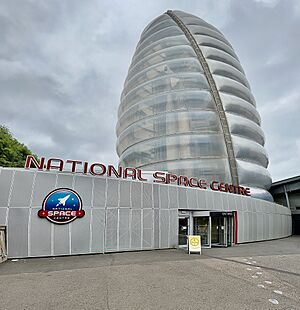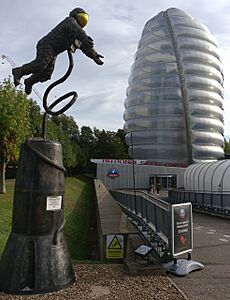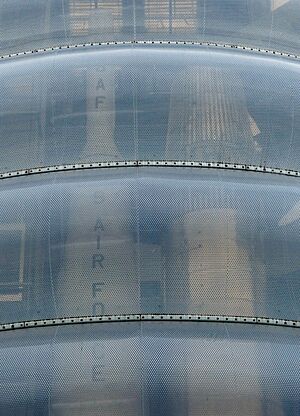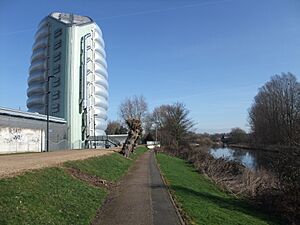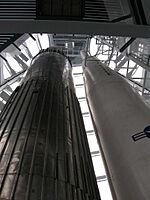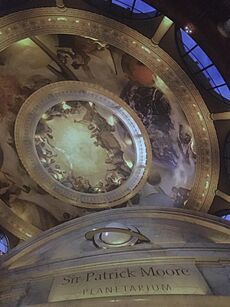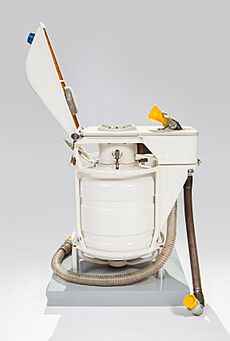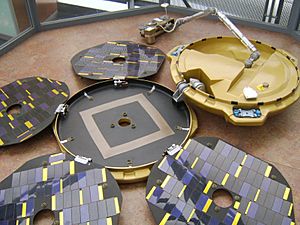National Space Centre facts for kids
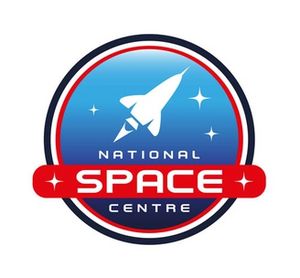 |
|
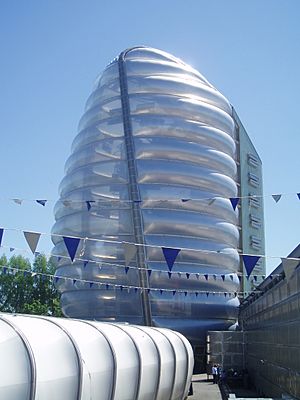
National Space Centre, Leicester
|
|
| Lua error in Module:Location_map at line 420: attempt to index field 'wikibase' (a nil value). | |
| Former name | National Space Science Centre |
|---|---|
| Established | 30 June 2001 |
| Location | Belgrave, Leicester LE4 5NS |
| Type | Space (and aerospace) museum |
| Visitors | 330,000 (2016) |
| Architect | Nicholas Grimshaw |
| Public transit access | First Bus 54 |
The National Space Centre is an exciting museum and learning place all about space science and astronomy. It also works with the University of Leicester on space research. You can find it in Belgrave, Leicester, England, right by Space Park Leicester and the River Soar.
Many cool exhibits, like huge upright rockets, are inside a special tower. This tower has a see-through covering made of ETFE 'pillows'. It has become one of Leicester's most famous buildings. The National Space Centre is home to the biggest planetarium in the United Kingdom. It is also a registered charity, which means it's run for public benefit.
Contents
How the Space Centre Started
The idea for a space centre first came up in the 1980s. Professor Alan Wells and Professor Ken Pounds from the University of Leicester thought of it. They wanted a research place that the public could also visit. But they couldn't find enough money back then.
Later, in 1995, Professor Alan Wells, Professor Alan Ponter, and Nigel Siesage brought the idea back. This time, they planned it as a museum.
A lot of money was needed to build it. The Millennium Commission gave half of the £52 million cost. Other big helpers included Leicester City Council, the University of Leicester, and BT. Many companies also helped by sponsoring exhibits.
The first part of the project was the Challenger Learning Centre. It opened at Leicester University in December 1999. A year later, it moved to the National Space Centre site. This was the first centre like it outside of North America. It had a room that looked like a spacecraft and another like mission control.
The centre was first going to be called the National Space Science Centre. But in December 2000, they changed it to National Space Centre. This was to avoid confusion with the British National Space Centre, which later changed its name to the UK Space Agency.
Grand Opening
The National Space Centre officially opened to everyone on June 30, 2001. Former NASA astronaut Jeffrey A. Hoffman was there for the big day. In its first five months, 165,000 people visited the centre. This was much more than they expected! It was even named Museum of the Year in 2002.
When it opened, over 60 scientists and astronomers worked there. They were part of a Space Science Research Unit.
Astronauts Who Visited
Many famous astronauts have visited the National Space Centre over the years.
Jeffrey A. Hoffman
NASA Astronaut Jeffrey A. Hoffman officially opened the centre on June 30, 2001.
Helen Sharman
Former astronaut Helen Sharman showed Queen Elizabeth II and the Duke of Edinburgh around. This happened on August 1, 2002, during the Queen's Golden Jubilee tour.
Michael Foale
On October 19, 2004, NASA Astronaut Michael Foale launched the new glass lifts in the Rocket Tower.
Bernard Harris
Bernard Harris, the first African American to walk in space, visited in March 2005. He was part of the centre's Festival of Science and Culture.
Buzz Aldrin
In June 2005, Apollo 11 Astronaut Buzz Aldrin came to the centre. He was the second person to walk on the Moon. He talked to children and explored the Lunar Base 2025 Experience.
Chris Hadfield
Commander Chris Hadfield visited on December 13, 2013. He met visitors and promoted his book, An Astronaut's Guide to Life on Earth.
Tim Peake
After his six-month mission on the International Space Station, Tim Peake visited on October 14, 2016. He spoke to local schoolchildren and visitors. He also received an honorary degree from the University of Leicester. While in space, he had linked live to the centre twice, answering questions.
Amazing Architecture
Nicholas Grimshaw, who also designed the Eden Project, created the National Space Centre. They won a design competition in September 1996. The building's inside was designed by C-Beck Group. The tower is 42 meters (138 feet) tall. It is special because it's the only place to have upright space rockets indoors.
The Building Design
The building is 7,360 square meters (79,222 sq ft) big. It was built on top of an old storm water tank. This helped save money and reuse the existing structure. The main rocket tower is covered in inflated pillows made of ETFE. This material is very light, only 1% the weight of glass. The Guardian newspaper called it "One of the most distinctive and intriguing new buildings in Britain." The main building has a metal skin that hides the windows. The roof has gravel in three colors, making a design like a crab nebula.
Construction started in March 1999.
Explore the Galleries
The National Space Centre has six main galleries. It also has a welcome hall, a planetarium, and a spaceflight simulator. You can also find a café and rooms for talks and teaching.
Welcome Hall
This is where you enter! It has a Soyuz 7K-OK Spacecraft and many spacesuits. You can see Tim Peake’s spacesuit, Buzz Aldrin’s underwear, and even a spacesuit from The Martian movie.
Into Space Gallery
This gallery is all about space flight. It has a model of the Columbus module from the International Space Station. You can even see a space toilet!
The Universe Gallery
Learn how the universe formed in this gallery. Discover how humans study space and search for alien life.
The Solar System Gallery
This gallery focuses on the planets in our Solar System. It includes the TinyTarium, a special planetarium for very young visitors.
Home Planet Gallery
This gallery is about Earth. It shows how we observe our planet and how human actions are changing it.
Space Oddities Gallery
Here, you can see special items from the National Space Centre's collection. The curator regularly updates this gallery. It displays unique objects with interesting stories.
The Rocket Tower
The Rocket Tower tells stories from the space race. It holds two upright rockets: a PGM-17 Thor Able and a Blue Streak. The tower also has a real piece of Moon Rock!
LIVE Space
This area hosts talks, live video calls, and science demonstrations. You can also get the latest news from space here.
Sir Patrick Moore Planetarium
On January 26, 2012, Sir Patrick Moore visited to launch the Planetarium. It was renamed in his honor. This Full Dome Planetarium shows amazing immersive shows. Many of these are made by NSC Creative, a team based at the centre. The Planetarium has 192 seats.
Tetrastar Spaceport
Opened in 2022, this is a simulated trip into low Earth orbit. You get to experience what it's like to cruise on a spacecraft.
Cool Things to See
You can view some of the National Space Centre's collections online. Just visit the National Space Centre Collections Online.
Moon Rock
There's a real piece of Moon Rock on display. It weighs 120 grams (4.2 ounces). Astronaut Gene Cernan collected it in December 1972 during Apollo 17. This was the last time humans visited the Moon. The rock is kept safe in a special container.
Sputnik Model
See a model of Sputnik. Its creation was watched over by its designer, Sergei Korolev. He wanted it to be perfect, saying, "This will be exhibited in museums."
Space Toilet
There's a model of a Russian space toilet. It looks just like the ones used on the Russian Mir space station. This model shows how it works, but it doesn't have the parts to process waste.
Martian Spacesuit
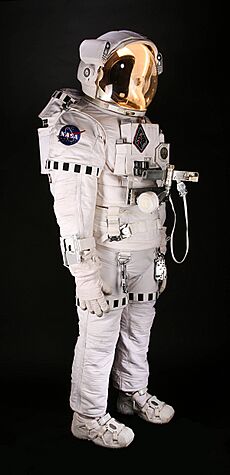
Check out an EVA Spacesuit from the 2015 film, The Martian. Matt Damon and stunt performers wore it. The designers worked with NASA to make it look like a real future spacesuit for Mars.
Beagle 2 Operations Centre
The mission control for the Beagle 2 mission to Mars was at the National Space Centre. This was the first time a NASA or ESA mission was run where the public could watch. The robotic arm of Beagle 2 was developed by the University of Leicester.
Learning and Education
The National Space Centre offers programs to help kids learn about science. They support parents and teachers in inspiring children.
e-missions
In 2004, the centre launched e-Missions™ with the Challenger Center for Space Science Education. In one mission, students had to save a crewed mission to Europa, one of Jupiter’s moons. Another mission, Operation Montserrat, had students act as a military team. They had to evacuate people during a hurricane and a possible volcano eruption.
National Space Academy
In 2008, the National Space Centre, University of Leicester, and others created the Space Academy.
The Space Academy worked with NASA. In 2010, they led a session at a big conference for space educators. Their presentation on the ESA’s Rosetta mission was even streamed online.
In February 2011, the National Space Academy officially launched. It was set up to promote science and technology. It trains teachers, offers learning materials, and helps students find careers in space.
As of 2022, they offer a Space Engineering course. Students can get A-levels in physics and math. They also get a BTEC Extended Diploma in engineering. The course is taught at Loughborough College and the National Space Centre.
The National Space Academy has many online resources. These include videos for learning about space and science at home.
Special Facilities
Digital Visualisation
The centre has its own team, NSC Creative. They make all the "fulldome" planetarium shows. By 2011, their shows were playing in over 220 planetariums in 27 countries.
Near Earth Objects Information Centre
This centre opened in January 2002. It gave information to the public about Near Earth Objects (NEOs). These are space objects that come close to Earth. It explained the science behind them and any possible dangers.
Government funding for this centre ended in 2010, and it closed. Now, the Spaceguard Centre monitors near-Earth objects.
Exciting Events
Queen's Visit

Queen Elizabeth II and the Duke of Edinburgh visited on August 1, 2002. This was part of her Golden Jubilee National Tour. The Queen gave a speech during her visit.
Olympic Torch Relay
On July 3, 2012, the Olympic Torch Relay came to Leicester. At the National Space Centre, a stuntman called “Jet Pack Man” carried the torch over the Rocket Tower. Then, he handed it to Kevin Davies, who left with an honor guard of Stormtroopers.
Other Fun Events
- The first Star Wars Day was held on July 30, 2005. It was so popular that Star Wars Weekend has been held every year since 2015.
- In November 2013, the centre celebrated 50 years of Doctor Who.
- In 2007, the National Space Centre celebrated "50 Years in Space." This marked the anniversary of Sputnik, the first satellite.
Images for kids
How the Centre is Run
The National Space Centre became a registered charity on January 10, 2000. It has 17 Trustees who help guide it.
The centre does not get daily money from the government. It earns money mainly from ticket sales, its café, gift shop, and by renting out spaces. As a charity, it also gives grants to other groups. It provides resources, facilities, and information.
See Also
- British National Space Centre
- Abbey Pumping Station - a museum next door
- NSC Creative - a company based at the National Space Centre that makes full-dome shows


